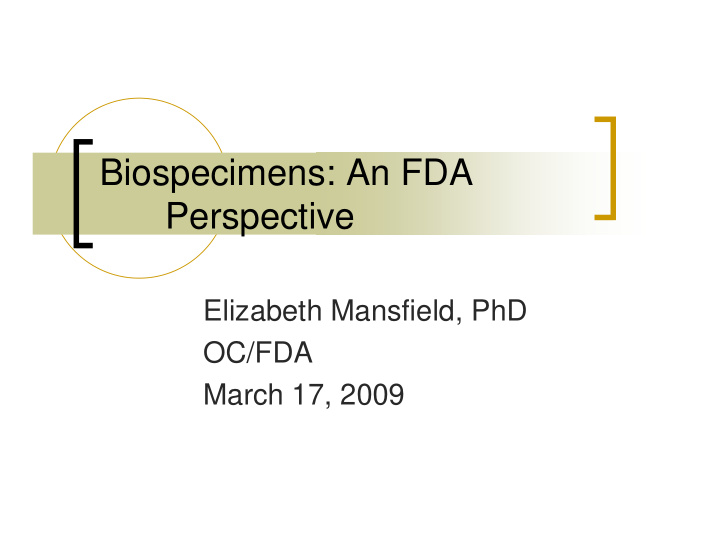



Biospecimens: An FDA Perspective Elizabeth Mansfield, PhD OC/FDA March 17, 2009
What is quality? � Biospecimen quality: minimal or controlled non-biological variability introduced into the specimen as a result of collection, handling, storage, and processing
How can quality be achieved? � Controlled protocols and conditions � Evidence-based practices � Patient preparation � Sample � Collection � Handling � Storage � Processing
Optimal biospecimen characteristics � Protocol-driven/evidence-driven and documented Collection � Handling � Storage � Processing � � Rich clinical annotation Demography � Clinical characteristics/outcome �
Regulatory Importance � Biospecimen quality as a regulatory issue New sensitive technologies: RNA, plasma � proteome, etc Known lability/variability of analytes � 20% of HER2 testing inaccurate (ASCO guidelines, � Wolff et al, JCO 2007) Minimal evidence base for establishing quality � criteria Few requirements for sponsor control of quality �
Potential consequences � Premarket Poor quality biospecimens in development � Miss real associations � Identify spurious/false associations � Waste $$, time, opportunity � � Postmarket Poor quality biospecimens in clinical practice � Decreased confidence in diagnostic performance � Patient consequences � Misdiagnosis � Wrong or suboptimal therapy �
Diagnostic tests � FDA regulates in vitro diagnostic tests (IVDs) of all kinds � Premarket submissions almost always contain analytical testing using samples derived from patient specimens � Real life test performance may reflect differences in specimen quality
Stored/archived specimens Many IVD manufacturers can make use of stored or � archived specimens/samples to validate assays Specifically collected/archived � Purchased � “Leftover” � Often don’t know how much information about � collection/storage/handling is available with such samples When does it matter? � What information is needed? �
Practical problems � Optimal conditions and information for specimen difficult to obtain/assess for retrospectively collected specimens � IVD sponsors have difficulty demanding collection/handling parameters, esp. if no practice guidelines/standards available Cost � Availability �
Existing and emerging areas of concern � Existing assays Certain hematology tests—labile factors, cells � Certain IHCs for unstable proteins � Metabolites, e.g., glucose � Micro-organisms, e.g., labile viruses, � anatomically specific organisms � Newer technologies where analyte(s) are known to be labile Expression arrays � Proteomic approaches, esp. serum proteome �
Clinical/demographic information Sufficient information to determine whether samples � are within the intended use population may not be available Incomplete/absent clinical data for assessing how � diagnosis was made can cripple/kill studies Both unbiased selection and enrichment strategies � impaired when clinical info not complete Lack of outcome data associated with specimen � may preclude use in retrospective studies
Current review practices Known relevant specimen variables must be controlled � Glucose—time to measurement, storage temperature, etc. � Viruses—only fresh samples, or stored within described � parameters Hematology—only fresh samples, or evidence of stored sample � comparability to fresh Often no described control for � FFPE tissues for IHC � Others � Ad hoc formulation of controls for new assays � Are we getting it right? What is existing evidence base? �
Ex: Gene expression testing Preanalytical Factors Consideration of preanalytical factors is critical for high-quality genomic tests . Specimen collection You should evaluate all sample collection, transport, and storage options you recommend (e.g., RNA preserving fixatives, frozen, fixed paraffin-embedded tumor tissue). You should ensure that the test is validated using specimens that are handled in the same manner as will be recommended in the test label (e.g., collection, storage, shipment methods). You should validate that the allowable elapsed time between tumor resection and preservation (e.g., by snap freezing, fixation or other methods) results in uniformly acceptable specimens. You should specify the specimen transport conditions. You should validate that the transport conditions are adequate to ensure sample integrity, and to determine the limits of transport variability that are acceptable (e.g., time in transit, quantity of coolant required). Your validation of appropriate storage conditions should include both the sample and the extracted RNA product. --From Class II Special Controls Guidance Document: Gene Expression Profiling Test System for Breast Cancer Prognosis
Biomarker qualification and companion diagnostic tests � In the context of drug development, studies to discover and validated biomarkers (predictive, prognostic, etc.) are likely to have similar issues Prospective specimen collection on phase 2/3 � trials will benefit from standardized collection/storage/handling protocols � If 3 rd party diagnostic device is needed to direct therapy, measures to assure specimen comparability will be needed.
Needs � Best practice guidelines � Standards � Evidence � Impetus (=$$?)
Future activities Guidance? � Provide specific regulatory advice to sponsors regarding biospecimen � quality Phase in recommendations for biospecimen quality reporting in � regulatory submissions? Provide biospecimen quality parameter reporting capability in regulatory � submissions CDER, CBER, CDRH � Gather additional information on biospecimen quality? � IT structures to data-mine existing data for evidence criteria � caTissue Core example: path/clin annotation function � FDA research program? � develop biospecimen quality parameters using scientific evidence �
� elizabeth.mansfield@fda.hhs.gov Thank you
Recommend
More recommend